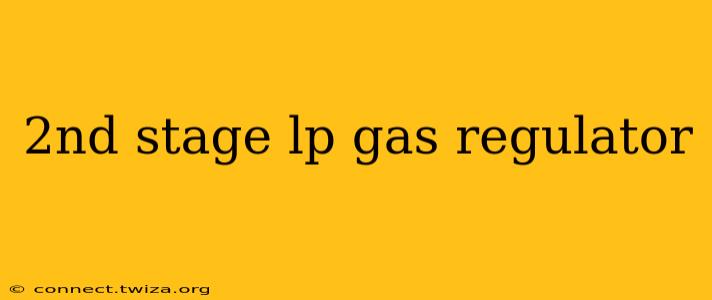The humble LPG (liquefied petroleum gas) regulator is often overlooked, a silent guardian ensuring safe and efficient gas flow to your stovetop. While many understand the role of the main (first-stage) regulator, responsible for reducing pressure from the tank, the second-stage regulator is equally crucial for safe and consistent gas delivery to your appliances. This post delves into the intricacies of the second-stage LPG regulator, exploring its function, components, troubleshooting, and safety considerations.
What is a 2nd Stage LPG Regulator?
The second-stage regulator is the final component in the gas delivery system, sitting between the gas pipe and your appliance. Unlike the first-stage regulator, which handles the significant pressure drop from the tank, the second-stage regulator fine-tunes the pressure to a level suitable for your gas stove or other appliance. This ensures consistent and safe combustion, preventing dangerous fluctuations in gas flow. It's designed to maintain a low, constant pressure even as you adjust the gas flow, allowing for precise flame control.
How Does a 2nd Stage LPG Regulator Work?
The second-stage regulator utilizes a diaphragm and spring mechanism to maintain a consistent output pressure. As gas flows through the regulator, the diaphragm moves, compressing the spring. This movement is precisely calibrated to regulate the pressure and ensure a steady gas supply to your appliance. Any increase in demand (turning up the gas) causes the diaphragm to move further, allowing more gas to flow while still maintaining the regulated output pressure. Conversely, reducing the gas flow causes the opposite reaction, reducing the gas supply.
What are the Components of a 2nd Stage LPG Regulator?
A typical second-stage regulator comprises several key components:
- Inlet Port: Where the high-pressure gas from the first-stage regulator enters.
- Diaphragm: A flexible membrane that moves in response to pressure changes, regulating gas flow.
- Spring: Provides the counterforce to the diaphragm, maintaining the set output pressure.
- Valve: Controls the gas flow based on the diaphragm's movement.
- Outlet Port: Where the low-pressure gas exits to the appliance.
- Pressure Gauge (Optional): Some regulators include a gauge to monitor the output pressure.
Common Problems with 2nd Stage LPG Regulators
While robustly built, second-stage regulators can malfunction. Recognizing these issues is vital for safety:
- Low Gas Flow: This often indicates a problem with the regulator itself, potentially a clogged inlet or a malfunctioning diaphragm. It could also signal a blockage in the gas line.
- Inconsistent Gas Flow: Fluctuating flames might be due to a faulty diaphragm or spring, failing to maintain consistent pressure.
- Gas Leaks: A hissing sound or the smell of gas indicates a serious leak requiring immediate attention. Turn off the gas supply immediately and contact a qualified technician.
How to Test a 2nd Stage LPG Regulator (Caution: Proceed with extreme care!)
Testing an LPG regulator should only be attempted by a qualified technician due to the inherent risks associated with working with gas. Incorrect handling can lead to serious injury or even death. A professional has the proper tools and training to safely assess the regulator's function and identify any potential issues.
Is it Safe to Use an Old 2nd Stage LPG Regulator?
While a regulator might appear to function correctly, its internal components can degrade over time due to wear and tear. Using an old or damaged regulator poses a significant safety risk, increasing the likelihood of gas leaks and potential explosions. Regular inspection and timely replacement are crucial for safety. Refer to the manufacturer's recommendations regarding the regulator's lifespan.
How Often Should I Replace My 2nd Stage LPG Regulator?
There's no universally agreed-upon timeframe for replacing a second-stage LPG regulator. However, regular visual inspection for signs of damage, corrosion, or leaks is highly recommended. If you notice any issues, immediately replace the regulator. Consult the manufacturer's guidelines for specific recommendations regarding replacement intervals. Safety should always be the top priority.
This information is for educational purposes only and does not constitute professional gas appliance advice. Always consult with qualified professionals for any gas appliance related issues. Improper handling of LPG can lead to serious injury or death.
